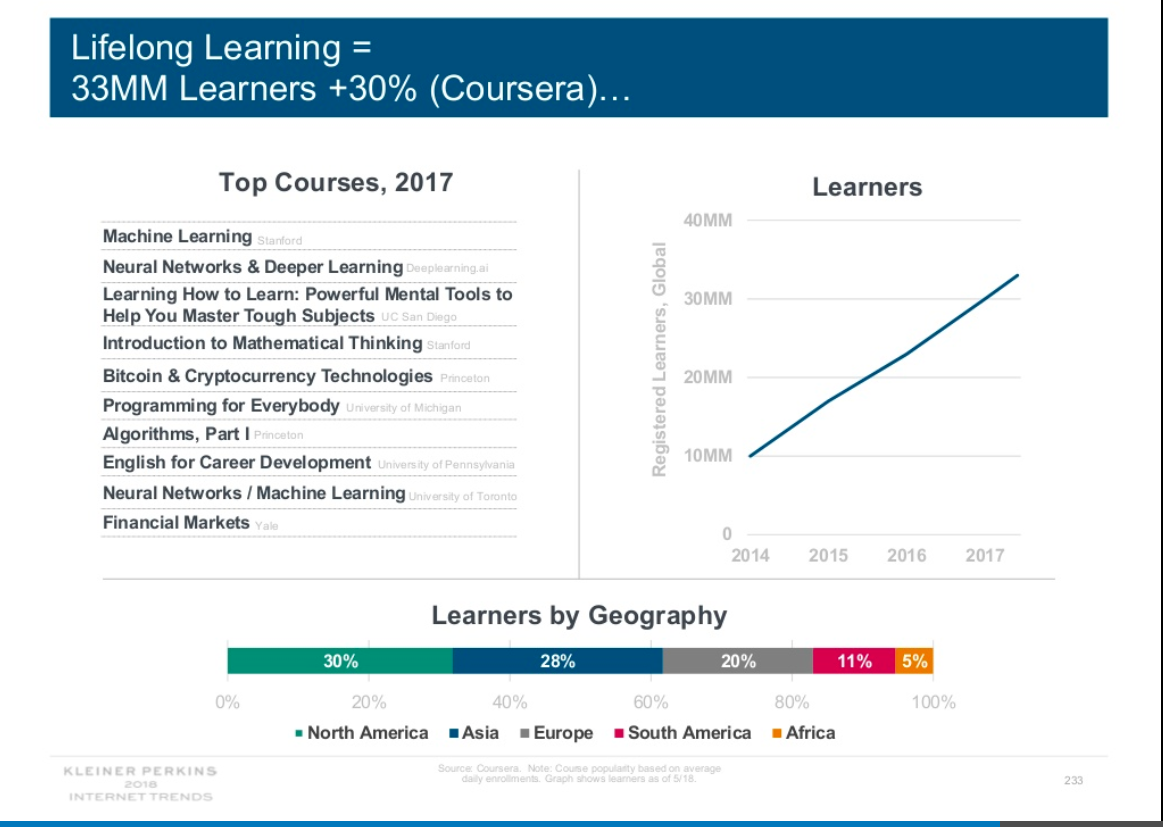You have /5 articles left.
Sign up for a free account or log in.
Spending some time with the 2018 edition of Mary Meeker’s annual Internet Trends presentation should lead higher ed people to draw the following conclusions:
- Mary Meeker is not hanging out with instructional designers.
- Higher education is maybe less on Meeker’s mind than it is on ours.
- Money people want to talk more about lifelong learning than they want to talk about the future of higher education.
On conclusion No. 1, all that needs to be said is that Meeker gleefully violates all the guidelines that presenters are given for constructing their slides. As presenters, we are told that PowerPoint is a poor medium for information transmission. That dense materials with many data points do not lend themselves well to PowerPoint, or at least to presentations where PowerPoint is used. We are told that slides should drive emotional connections with a few big points or ideas that the audience will remember.
Well, maybe all that advice is wrong. Meeker creates perhaps the most important PowerPoint presentation of each year.
For conclusion No. 2, I can’t help but to feel a bit -- well -- left out. How is that we can spend all of our energy talking about higher education, only to have Mary Meeker not talk about higher education at all?
Why is it that higher education is more interested in Mary Meeker than she is in us?
Perhaps the answer comes down to the fact that Meeker is a venture capitalist. Higher education remains largely a nonprofit business. The ed-tech sector may be too small to catch Meeker’s attention.
Still, I’d argue that in not considering the role of the internet and mobile in how postsecondary education is changing that Meeker is missing one of the big technology stories of our time.
For conclusion No. 3, that Meeker is interested in lifelong learning, I think the best thing to do is to share all the slides on this topic.
Slide 232 introduces the topic:

Here, Meeker’s big takeaway is that lifelong learning is critical for employers, and that the tools to continually retrain workers are improving.
Slide 233 is all about Coursera:

Meeker highlights the growth in the Coursera installed learner base -- which is now up to a truly impressive 33 million. The top courses for 2017 are also listed.
Here I wish that Meeker had included data from edX. Combining the edX numbers of 15 million learners with Coursera’s would have been impressive. I also think that Meeker could have integrated the open online learning story with the growth of online learning for degree programs. These two stories are intermingled in a way that is not very well understood.
In slide 234 Meeker shares some lifelong learning numbers from YouTube:

I had no idea that YouTube got a billion daily views for learning videos. This slide also shows the impressive growth of platforms such as Khan Academy and TED-Ed between 2013 and 2018.
The story here, I think, is impact. Online video seems to be where the action is when it comes to just-in-time learning. What is interesting to me is that YouTube and other video platforms are not all that important, from an instructional standpoint, for colleges and universities. Online and mobile instructional video lives in a largely separate and distinct world from higher ed instruction. Why is that?
Slide 235 highlights what AT&T is doing for work-force training:

Meeker thinks that AT&T is the model for how companies should invest in a future-ready work force. The $1 billion that AT&T has allocated for employee training is truly impressive.
This slide makes me wonder if a wide enough array of colleges and universities are doing enough to partner with companies. I’d argue that we know how to do education. That Coursera and Udacity provide a commoditized platform, and that higher education knows about authentic learning.
Some schools, such as Arizona State University, are doing a great job in partnering with companies for lifetime employee education. At other schools, this work with companies happens mostly in business schools, and in executive education divisions.
It seems as if the opportunity for partnerships between higher ed and companies is much bigger than most of us realize.
Slide 236 presents data on how freelancers are upgrading their skills.

It is an interesting question of how universities can become more relevant to gig workers. How many of our graduates will be freelancers? And what lifelong education opportunities are we offering to them?
Here is the full deck of Meeker’s Internet Trends 2018.




